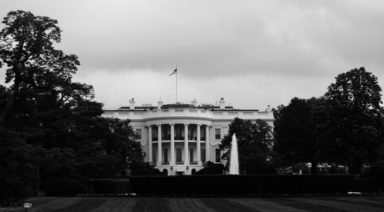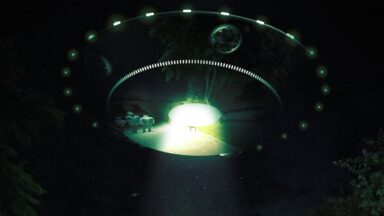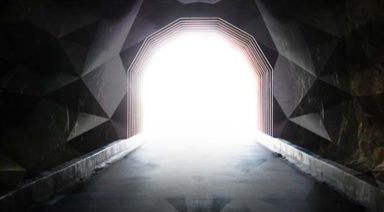Nazi UFO Technology: Foo Fighters Exposed

It was just before Christmas in 1944. An American Air Force pilot was flying over enemy territory, carefully looking out for a German war plane, when he and his radio operator both saw round glowing objects approaching. The unidentified flying objects (UFOs) got behind the U.S. military plane and began following it. The American pilot tried several maneuvers in an attempt to lose the mysterious objects, but even a steep dive or sharp turns could not lose them. Suddenly, the objects disappeared. Surprisingly, during the entire encounter, neither the American pilot nor the mysterious objects fired any shots.
This is just one example of many similar incidents that occurred over the skies of Germany during the last few months of World War II. Sometimes, the objects showed up on radar screens. Other times, more than one person observed the objects but they did not show up on radar. What were the mysterious objects? Were they UFOs from extraterrestrials? Or were they some sort of Nazi Ufo experiment? No one can be sure, but there are a variety of theories.
The Foo Fighters
Toward the end of the war, U.S. pilots frequently reported nighttime sightings of these UFOs. The objects always traveled at great speeds and were able to make maneuvers to keep up with American planes. The Allies worried that Germany had created a new weapon even though no shots were ever fired.
The objects received the nickname “foo fighters” after a popular cartoon of the time called “Smoky Stover.” In the cartoon, the Smoky character often said, “Where there’s foo there’s fire.” The term caught on and even radar operators used the term “foo fighter” to alert pilots of sightings.
Although most of the encounters occurred over Europe, there were a few similar incidents that occurred over the Indian Ocean. Interestingly, after the war was over, the Allies discovered that the Axis powers had also seen the objects, and feared that the Allies had developed a secret weapon.
Also after the war ended, Rudolf Lusar, a major from the German Army, wrote a book about secret weapons used by Germany during the war. He described two types of golden ball-shaped objects the Allied pilots identified during the war. One version he referred to as the “Feuerball.” The other was the “Kugelblitz.”
According to Lusar, the devices were jet-propelled and guided automatically. Their purpose was to emit electrostatic discharges from Klystron tubes to disrupt the electrical systems of the Air Force bombers’ engines and prevent them from dropping bombs.
Although Lusar’s description seems plausible, researchers disagree about the validity of his account. For instance, not a single Allied plane ever reported complications from an encounter with a foo fighter. So, it seems that if the Germans had developed such a weapon, they would have been able to replace the ineffective klystron tubes with a substance that would have accomplished their goal.
To date, no conclusive explanation for the foo fighters have ever been found. So the question remains, what technology was available to the Germans and how did they use it?
German Development of Technology and Exploration of Antarctica
Maria Orsic and the Vril Society
It’s no secret that the Germans used all their available resources in an attempt to be the greatest nation in the world. One of their great pursuits at the time was space travel. To reach their goal, they used the information provided by psychic Maria Orsic and the Vril Society to assist them. When Orsic channeled the blueprints and instructions for building a circular flying machine, the Vril Society began paying for and assimilating parts from other industrial sources.
Maria Orsic and other Vril Society members met with Hitler, Himmler and others in January 1944 to discuss the circular flying machine project. There was at least one test flight late in the year which did not end as all had hoped for. The machine returned more damaged than expected after its flight to another planet.
Instead of continuing work on the project and channeling helpful information, Orsic disappeared. She was last seen in early 1945. On March 11, 1945, she sent a letter to members of her organization that ended with the statement, “niemand bleibt heir,” or “no man stays here.”
No Vril member, including Maria, was ever seen or heard from again. Did they escape to outer space? Meanwhile, did Germany continue its experimentation with circular spacecraft?
Viktor Schauberger and German UFOs
Viktor Schauberger was an Austrian physicist and inventor who rose to prominence in Nazi Germany. He was widely known for his vortex experiments using water and fish. He then developed turbines that could create anti-gravity propulsion.
In 1939, Hitler summoned Schauberger to Berlin for a meeting. At first, Hitler greeted Schauberger warmly and said he called the meeting to discuss Schauberger’s work. However, the meeting lasted for approximately 11 hours before Schauberger could leave.
In 1943, Schauberger was 58 years old and suffering from war wounds. Even so, he was drafted into the German Waffen-SS and placed under the direct control of Heinrich Himmler. Himmler forced Schauberger to research and develop a new secret weapon and threatened to kill him if he did not cooperate. Schauberger was then housed at Schloss Schoenbrunn so that engineers imprisoned nearby could assist him with his work.
Schauberger was not an easy pushover. Despite receiving death threats, he refused to work unless he could personally select the engineers to be on his team. He further demanded that his engineers gain freedom from the concentration camp, were properly clothed in civilian clothes, given adequate food, and were housed in civilian accommodations. He argued that if his workers feared for their lives, it would stifle their creativity and make them unproductive.
Surprisingly, the SS agreed to his demands. He chose approximately 30 engineers and other workers to leave the concentration camp and be housed in civilian housing exactly as he had demanded. When he first assembled his group, he lectured them about how important it was for them to work hard and never try to escape. He told them if any one of them tried to escape, he himself would face execution. They did what Schauberger told them to do and developed two machines. At the end of the war, the Allies confiscated the top secret information, forever concealing this technology from the public.
1930s German Exploration of Antarctica
In the late 1930s, Germany dedicated substantial resources to exploring Antarctica. In 1943, German Grand Admiral Donitz proudly proclaimed, “The German submarine fleet is proud of having built for the Fuhrer, in another part of the world, a Shangri-la land, an impregnable fortress.” During the 1938-39 expedition, the Germans claimed to find ice-free lakes with warm water and surrounding vegetation. The Germans named their new Antarctica colony “Neuschwabanland.”
There were reports that when the Nazis faced defeat, some scientists actually escaped in U-boats filled with mercury to head to their Antarctica fortress. Two of the boats had mechanical difficulties and surrendered in Argentina. One U-boat wrecked in Indonesia and another sank in a Norwegian fjord. Meanwhile, a large number of U-boats were never found. Could they have made it to their Antarctica destination?
Did Germany have more resources than the Allies believed? Where did the mercury come from, and what did the Germans plan to use it for?
Operation Paperclip Confirms Germans Had Brilliant Scientists And Advanced Technology
As the war came to an end, the United States recognized that Germany had technology that might be helpful to the U.S. As a result, General Patton captured German factories in Silesia that housed proprietary technology and weapons. There was substantial evidence that Germany was working on circular aircraft that could work not just in the Earth’s atmosphere, but also outside of it. It seemed obvious that the Germans had the technology and scientists but not the resources (such as oil, electricity and the necessary facilities) to produce such an advanced aircraft. For this reason, the U.S. attempted to extricate scientists from Germany and bring them to America. The program had a codename of Operation Paperclip.
The scientists, who specialized in aerodynamics, rocketry and chemical weapons, were of particular interest. They were silently and secretly relocated within the U.S. without going through the State Department’s strict approval process. Most notably among them was Wernher von Braun.
Before and during the war, von Braun was head of the Germans’ rocket development program. After coming to the U.S. by way of Operation Paperclip, he became a naturalized citizen and eventually became the director of the U.S. National Aeronautics and Space Administration (NASA). He is considered the father of the American space program.
Operation Highjump
Even as they were basking in the glory of the win, the Allies had suspicions that something was amiss.
In response to interrogations, some Germans revealed that there was a secret German base in Antarctica. The government decided to send famed Admiral Richard Byrd to investigate a concern that there still may be weapons stashed in the secret hideout.
In the late summer of 1946, Byrd headed to Antarctica with about 4,700 military personnel along with naval support ships. They had at least one aircraft carrier as they embarked on “Task Force 68,” nicknamed Operation Highjump. The expedition had several months to complete its mission, but ended after only about eight weeks due to heavy casualties.
On the way to their destination, Byrd and his crew reported experiencing a “mysterious UFO force” that destroyed several of their airplanes and ships and killed several crew members. Was this perhaps the “first known historical incident involving a battle between U.S. naval forces and an unknown UFO force stationed in Antarctica?”
Byrd continued onward. He found Neuschwabenland, which featured underground caverns flowing with warm water and signs of vegetation. But, he and his men could not stay long nor could they do any major exploration. They were continually bombarded by aircraft and forced to leave. Had they perhaps found a post-war hiding place for Nazis who had actually been able to escape?
On their way home, Byrd and his group stopped briefly in Santiago, Chile, where Byrd was interviewed while still aboard the expedition’s command ship. Byrd warned that although he was not trying to scare anyone, it was clear to him that if there was a new war, the U.S. could face attack via planes flying over one or both of the poles. He noted that with the “fantastic speed with which the world is shrinking” the U.S. would no longer be safe. After that interview, Byrd rarely spoke about his Operation Highjump experience.
In 2006, a Russian intelligence report included the testimony of two U.S. Navy Seamen who had been on Admiral Byrd’s Operation Highjump expedition. Both seaman recounted seeing brightly lit UFOs appear dramatically out of the ocean. They watched them soar into the sky and disappear. The troops fired at the UFOs, but the UFOs never fired back. Some on the expedition concluded that the UFOs had a mission to deter them and send them away, not to harm them.
Were the UFOs encountered by Admiral Byrd protecting Nazis hiding out in Antarctica? Were they exclusively built by German scientists to deter its earthly enemies or did they come from the Vril Society’s mysterious planet? The question still stands today, but there’s always more to learn.
Want more like this article?
Don’t miss Deep Space on Gaia for more on the long and hidden history of Earth’s secret space program.
Avi Loeb on How We Should Prepare For UFOs and Alien Contact

UFO sightings are on the rise this year, the U.S. government appears to be taking disclosure seriously, and more former intelligence officers are speaking out about UFOs. It begs the question, ‘what do we do if extraterrestrials show up?’
Interest in UFOs and calls for disclosure have shifted from a fringe movement to a more mainstream one. For years, ufologists have demanded full exposure of all alien contact with humans, but what should we actually do if extraterrestrials make themselves known to us on Earth or in space?
That’s the question posed by Harvard Professor of Science Avi Loeb, in his latest article for Scientific American. Professor Loeb, author of “Extraterrestrial: The First Sign of Intelligent Life Beyond Earth” thinks we should be prepared for an alien arrival.
Watch more:




































